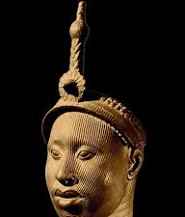Yorùbá origin of European Mathematics and Vigesimal System

On the 9th of March 1886, members of The Royal Anthropological Institute of Great Britain and Ireland met in London to examine the paper titled: Note on the Numeral System of the Yoruba Nation authored by Adolphus Mann Esq.
The following are some of the excerpts from Adolphus Mann’s report regarding the Yorùbá Numeral System:
“…Perhaps the following notes on the numeral system of the Yoruba nation may interest the student of ethnology and languages, and may be of some use in investigating the nature of the mind that can form such an unusual, yet regular structure… suffices to understand the peculiarities in the arrangement of these numerals to which analogies in other languages are but rarely found.
We light, as it were on a building, which, when viewed from base to summit is not behind our European systems in regularity and symmetry, while the system surpasses them [European systems] in the aptitude of interIinking the separate members; it stands to them in the same relation as the profusely ornamented Moorish style stands to the more sober Byzantine.” (page 59 – 60).
Mr Adolphus Mann, in his report postulated that this inspiring Yorùbá System originated from the ways cowrie shell currency was counted by the Yorùbá traders and business people:
“When a bagful [of cowries] is cast on the floor, the counting person sits or kneels down beside it, takes 5 and 5 cowries and counts silently, 1, 2, up to 20, thus 100 are counted off, this is repeated to get a second 100, these little heaps each of 100 cowries are united, and a next 200 is, when counted swept together with the first. Such sums as originate from counting are a sort of standard money, 20, 100 and then especially 200, and 400 is 4 little heaps of 100 cowries, or 2 each of 200 cowries, representing to the Yorubas the denominations of the monetary values of their country as to us 1/2d., 1d., 3d., 6d., 1s., &c.” (page 62).
Note:
d = pennies
s = shillings
The key point for us is from the first excerpt:
“When viewed from base to summit is not behind our European systems in regularity and symmetry, while the system surpasses them [European systems] in the aptitude of interIinking the separate members; it stands to them in the same relation as profusely ornamented Moorish style stands to the more sober Byzantine”
For a British scientist to admit this in 1886 was unheard of! Mr Mann was effectively saying that the Yorùbá Numeral System was superior to the Europeans when linking numbers together – “while the [Yorùbá] system surpasses them [European Systems] in the aptitude of interIinking the separate members”.
This is not only phenomenal but it does demonstrate that the Yorùbá Numeral system (vigesimal) is not inferior to other Numeral Systems.
The Vigesimal System has been instrumental to the phenomenal business acumen of Yorùbá women to this day.
Before the arrival of the British on the shores of Yorùbáland and the eventual colonisation of the country from 1861 to 1960, Yorùbá women held sway in business (they still do these days to some extent).
They were and still are the main participants in the marketplace hence the existence of chieftaincy titles like Ìyálọ́jà (Mother or custodian of the market) and Ìyálájé (Mother or custodian of the economy).
It is a known fact that Mathematics/Arithmetic is the language of business and trade. In a society where orality eclipsed literacy, the only way to become an astute businesswoman was to be well versed in the art of mental Arithmetic.
Being able to perform complex arithmetic mentally without any computing device like abacus (used then in Europe and Asia) was a monumental feat but this was helped by the vigesimal (Base 20) Numeral System. The Yoruba version was developed many centuries ago in the heartland of Yorùbáland.
This is best demonstrated using the following examples:
15 ẹ́ẹ́dógún (from arun din ogun = five reduces twenty)
16 ẹẹ́rìn-dín-lógún (20 – 4)
17 ẹẹ́tà-dín-lógún (20 – 3)
18 eéji-dín-lógún (20 – 2)
19 oókàn-dín-lógún (20 – 1)
20 ogún
21 oókàn-lé-lógún (“one on twenty” = 20 + 1)
25 ẹ́ẹ́dọ́gbọ̀n (30 – 5)
30 ọgbọ̀n
35 aarun-din-logoji (five less than two twenties = (20 X 2) – 5)
40 ogójì (from ogún méjì – “twenty twos”)
50 àádọ́ta (20 X 3 -10)
60 ọgọ́ta (3 X 20, i.e twenty in three ways)
100 ọgọ́run = orun (20 X 5)
105 aárun din laadọfa (20 X 6 – 10 – 5)
200 igba
300 ọọdunrun = ọọdun [20 X (20 – 5)]315 orin din nirinwo odin marun [400-(20 X 4)-5]400 irinwo (A big number like an elephant)
2000 ẹgbẹwa (200 X 10)
4000 ẹgbaaji (2 X 2000)
20,000 ẹgbaawaa (2000 X 10)
40,000 ẹgbaawaa lonan meji (ten 2000s in two ways)
1,000,000 ẹgbẹẹgbẹrun (1000 X 1000)
This can be taken a little bit further by exploring the flexibility of Yoruba when it comes to big numbers.
In English language for example, the number 19,669 is just “Nineteen thousand, six hundred sixty-nine”
In Yoruba however, there are at least nine ways to skin this “19,669” cat as shown below (Adapted from Ẹkundayọ, S. A. seminal work see Reference)!
Remember that this is done effortlessly mentally in the head without the aid of any calculating device.
(a) Ọ̀kẹ́ kan ó dín ojìlélọdúnrún ó lé mẹsán
20,000 – (300 + 40) + 9 = 19,669
(b) Ọ̀kẹ́ kan ó dín irinwó ó lé ọkaàn dínláàdọ́rín
20,000 – 400 + (70 – 1) = 19,669
(c) Ọ̀kẹ́ kan ó dín ọ̀ọ́dúnrun ó dín ọ̀kànlélọ́gbọ̀n
20,000 – 300 – (30 + 1) = 19,669
(d) Ọ̀kẹ́ kan ó dín ọ̀tàdínirinwó ó lé mẹ́sàn
20,000 – (400 – 60) + 9 = 19,669
(e) Ẹ̀ẹ́dẹ́gbàáwàá ó lé ẹgbẹ̀ta ó lé ọ̀kàndínláádọrin
19,000 + 600 + (70 – 1) = 19,669
(f) Ẹ̀ẹ́dẹ́gbàáwàá ó lé ẹ̀ẹ́dẹ̀gbẹrin ó dín ọ̀kànlélọ́gbọ̀n
19,000 + 700 – (30 + 1) = 19,669
(g) Ẹ̀ẹ́dẹ́gbàáwàá ó lé ọ̀tàlélẹgbẹta ó lé mẹ́sàn
19,000 + (600 + 60) + 9 = 19,669
(h) Ẹ̀ẹ́dẹ́gbàáwàá ó lé ọ̀rinlélẹgbẹ̀ta ó dín ókànlàá
19,000 + (600 + 80) – 11 = 19,669
(i) Ẹ̀ẹ́dẹ́gbàáwàá ó lé ójìlélẹgbẹta ó lé mọkandínlọgbọn
19,000 + (600 + 40) + 29 = 19,669
Reference:
(1) Mann, Adolphus: “Notes on the Numeral System of the Yoruba Nation”. Journal of the Royal Anthropological Institute 16: 60, 1887.
(2) Ẹkundayọ, S. A. ‘Vigesimal numeral derivational morphology: Yoruba grammatical competence epitomized.’ Paper presented in the Linguistics Department, University of Ife, 1975.
Photo Credit: The New York Public Library Digital Collections
https://digitalcollections.nypl.org/items/510d47de-0fbf-a3d9-e040-e00a18064a99
Olobe Yoyon


